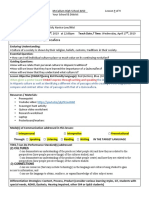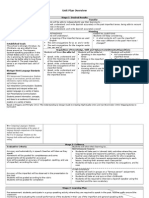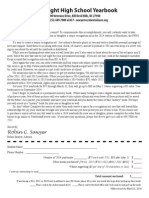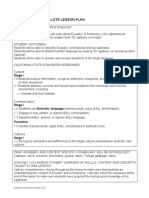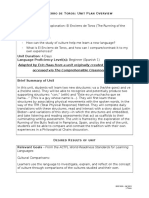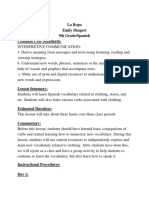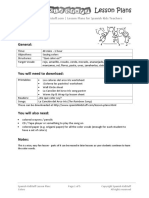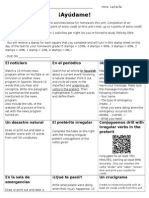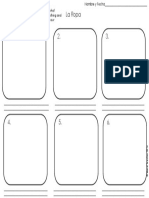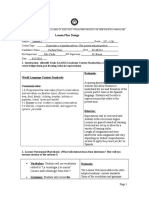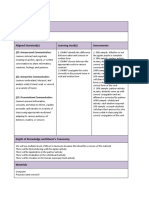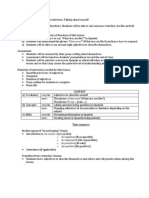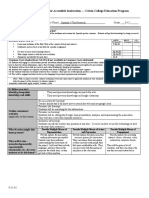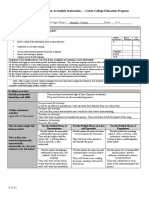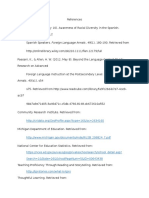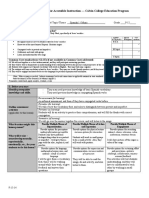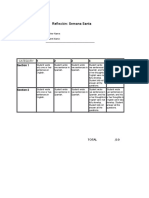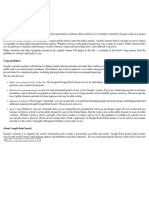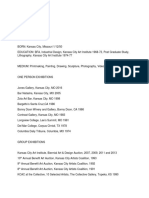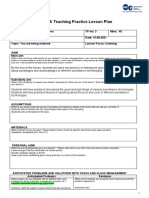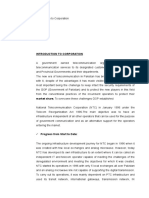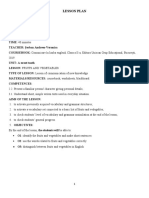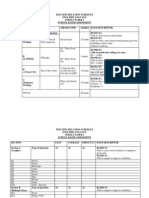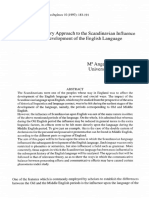Lesson Planning Form for Accessible Instruction Calvin College Education Program
Teacher
Griselda Bello
Date
Subject/ Topic/ Theme Spanish 1/ Overview of the Celebration
Grade ____9-12____________
I. Objectives
How does this lesson connect to the unit plan?
This lesson will give the student a better understanding of what the celebration is, why is celebrated in different days each year, and an inside of other countries
traditions.
cognitiveR U Ap An E C*
Learners will be able to:
Identify different types of celebration. Ex. historical, cultural y religious.
physical
development
socioemotional
RU
R U Ap
Identify Spanish vocabulary related to this celebration
Identify the most important days of this week, and their names in Spanish
To recall what and why we celebrate it, and why other countries celebrated as well
Explain why is celebrated in different days each year
Identify two of the main traditions of Spanish speaker countries
RU ApAn
U Ap
U Ap
U
Common Core standards (or GLCEs if not available in Common Core) addressed:
1.2 We will read together as a class written material, and they will participate answering comprehension questions in Spanish.
2.1 They will get an inside in understanding the relationship between the practices and perspectives of the cultures studies by looking a couple of their traditions.
4.1 Students will compare new Spanish vocabulary with words in English. They will find some cognates.
4.2 Also, they will start comparing how Semana Santa is celebrated in other countries and in the United States.
5.1 The students will learn vocabulary related to these celebrations. They may use it with Spanish speakers.
5.2 They will be engaged and interested to use the language for personal enjoyment and enrichment.
(Note: Write as many as needed. Indicate taxonomy levels and connections to applicable national or state standards. If an objective applies to particular learners
write the name(s) of the learner(s) to whom it applies.)
*remember, understand, apply, analyze, evaluate, create
II. Before you start
Identify prerequisite
knowledge and skills.
They man need a previous knowledge of basic vocabulary and Spanish sentence structure.
They may need to be familiar with some celebrations in their own country.
Pre-assessment (for learning):
I will start talking about the different types of celebration. Ex. Historical, cultural, and religious.
Outline assessment
activities
(applicable to this lesson)
What barriers might this
lesson present?
What will it take
neurodevelopmentally,
experientially,
emotionally, etc., for your
students to do this lesson?
9-15-14
Formative (for learning):
We will read a sheet with all the explanations of the Holy Week.
Formative (as learning):
Students will answer comprehension questions
Summative (of learning):
We will see some pictures of one of the main traditions of Spanish speaking countries, the precessions.
Provide Multiple Means of
Representation
Provide options for perceptionmaking information perceptible
Students may have problems
understanding how the date for the
Holy Week is stablish. I will give
them in written and in English the
definition of Equinox, and show
them a moon calendar, to explain
how it work in more detail and with
visual material.
Provide Multiple Means of Action
and Expression
Provide options for physical actionincrease options for interaction
They will answer the two sets of
questions with a partner. They will
also read the second part of the
informational sheet and translate it
together. This will give them the
opportunity to talk and collaborated
to each other learning, instead of
just listening to me.
Provide Multiple Means of
Engagement
Provide options for recruiting
interest- choice, relevance, value,
authenticity, minimize threats
They will have the information in a
sheet of paper and also will be
projected in power point
presentation for more visual aid.
Also, before the lesson I will give
them a curious fact about how in
the past the women in Mexico
named their children. And at the
end we will have some pictures of
the processions to increase their
curiosity.
�Provide options for language,
mathematical expressions, and
symbols- clarify & connect
language
Provide options for expression and
communication- increase medium
of expression
Provide options for sustaining effort
and persistence- optimize
challenge, collaboration, masteryoriented feedback
I will give a vocabulary sheet
previous to the lesson. We will
translate it as a class. Then with
the informational sheet, they
will see the new vocabulary in
context for better understanding
We will discuss and read the
material as a class, but also they
will work with partner for those
who do not like to speak in big
groups.
They will practice their
pronunciation with their
partners by reading the material
in Spanish, then they will
translate it alternatively to
collaborate and give feedbacks
to each other.
Provide options for comprehensionactivate, apply & highlight
Provide options for executive
functions- coordinate short & long
term goals, monitor progress, and
modify strategies
Provide options for self-regulationexpectations, personal skills and
strategies, self-assessment &
reflection
They will see the words in the
presentation as they listen to my
pronunciation. We will discuss,
read and answer questions with
their partners, then with the
whole class.
Materials-what materials
(books, handouts, etc) do
you need for this lesson
and are they ready to
use?
How will your classroom
be set up for this lesson?
As they work with their partners They will have the opportunity
I will be monitoring their
to self-assess by realizing how
progress and understandability.
much they understand the
Also, I will see areas where
material when they read it and
they are having problems with.
translate it by themselves first
A projector, to project the power point presentation with all the material and the pictures.
The vocabulary and Semana Santa sheets print out, to have a copy for each student.
Internet access to show the moon calendar.
It can be set up in any way. Each student should have at least one person next to them to work with,
without having to stand up.
III. The Plan
Time
5
3
2
4
9-15-14
Components
Motivation
(opening/
introduction/
engagement)
Describe teacher activities
AND
student activities
for each component of the lesson. Include important higher order thinking questions and/or
prompts.
1. I will start talking about the different types
1. Students will be listening and seeing the
of celebration, historical, cultural, and
words in the projector, figuring out what I
religious. I will introduce the questions
am saying. They will pay close attention
where they have to give at least one
to the instruction and listening to
example of each type of celebration in the
understand what they are being ask and
U.S. and if they know another example
how to answer. As I ask for translation of
from other country. I will go over each
key words, they should answer.
question to make sure they understand
what they have to answer. I will ask
students for the translation in English to
some key words. I will give them the
translation if they do not know it.
2. I will be walking around to monitor their
2. They will be answering the questions with
performance and answer any questions
a partner.
they may have.
3. I will go over the answers with the whole
3. Students will listen to the question and
class. I will ask each question at a time
raise their hands to answer and wait for
and different students will answer. I will
me to pick a student.
choose from those who raise their hands.
4. I will talk about the curious fact. Mexican
4. Students will be listening to the teacher
calendars have the name of a saint each
and looking at one example of the
day of the year. Mothers will give the
Mexican calendar in the projector.
name of the saint of the day their children
were born. My grandmother named my
dad, aunts, and uncle using the calendar.
�2
5
2
15
4
5.
6.
7.
Development
(the largest
component or
main body of
the lesson)
8.
9.
Closure
(conclusion,
culmination,
wrap-up)
9-15-14
I will give them the vocabulary sheet and
ask if someone knows the translation of
each.
I will give them the Semana Santa sheet
and read the first paragraph with the
whole class. I will ask them for the
definition of key words, and also let them
know that the highlighter words are in the
definition box at the right. Also, I will tell
them about the two notes at the bottom of
the page.
I will give them the instruction in how to
read the rest of the page. One student will
read the next paragraph in Spanish and the
other one will translate it. They will
alternate the work for the third and fourth
paragraph. The one who translate, now
will read, the one who read, now will
translate, and so on. When they are done,
they may answer the questions together.
I will be walking around listening to their
conversation, give any feedback if needed,
and answering any questions they may
have.
When I see that almost everybody is done
with the reading and with the questions, I
will call the attention of the class. I will
clarify how the days of the Holly Week
are determined. Explain what Equinox is
and show the moon calendar of the current
year to explain it. Then we will go over
the questions one by one. I will choose
who will answer from the students who
raise their hands.
10. I will show the pictures of the processions
of some Spanish speaking countries. Just
give a brief short description from where
the pictures are from to increase their
curiosity. Not give too much information
because they will do a research the next
class period. Clarify to students that the
pointy hats from Spain have nothing to do
with the KKK. This is an older tradition.
They use them to pay penitence for their
sins, so nobody can recognize them.
Different colors represent different church
denominations.
5.
6.
Students will be passing back the sheets
and answer if they know the translation of
any of the words.
Students will be listening and answer if
they know the translation.
7.
Students will listen to the instructions and
ask any questions if they do not
understand.
8.
Students will be working with their
partners the assignment they were just
given. They can ask questions to they
teacher at any time.
Students will stop talking and listen to the
teacher. As the teacher ask the questions,
they can raise their hands if they know the
answers, and wait to be call by the teacher.
9.
10. Students will be looking at the pictures in
the projector. They are free to ask
questions about them. And hopefully they
are curious to know more about it, and be
prepared to do their research the next class
period.
�Your reflection about the lesson, including evidence(s) of student learning and engagement, as well as ideas for improvement
for next time. (Write this after teaching the lesson, if you had a chance to teach it. If you did not teach this lesson, focus on the
process of preparing the lesson.)
When we talk about examples of the different types of celebrations from other countries, I notice that an international
student was excited to share celebrations from his country, while other students were not so familiar with other countries
celebrations. Probably he has few opportunities to feel as an expert of the subject, when everything else is new for him. I
wish I would have given him more time to share his experience and share a little bit about his traditions and culture. He
would have feel more proud, and we would have learned something new.
9-15-14

